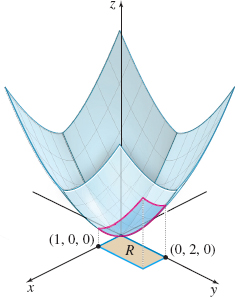EXAMPLE 1Finding Surface Area
Find the surface area of the part of the surface z=f(x,y)=23(x3/2+y3/2) that lies above the region R, a rectangle enclosed by the lines x=0, x=1, y=0, and y=2.

Figure 38 z=23(x3/2+y3/2)
Solution Figure 38 shows the surface z=f(x,y)=23(x3/2+y3/2) and the surface area S above the rectangle R. We begin by finding the partial derivatives of z=f(x,y): fx(x,y)=x1/2fy(x,y)=y1/2
Since fx and fy are continuous on R, the surface area S above R is S=∬